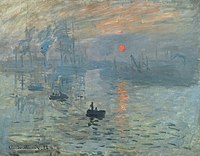
Photo from wikipedia
Purpose: The aim of this study was to present a new method to analyze the three-dimensional accuracy of complete-arch dental impressions and verify the reliability of the method. Additionally, the… Click to show full abstract
Purpose: The aim of this study was to present a new method to analyze the three-dimensional accuracy of complete-arch dental impressions and verify the reliability of the method. Additionally, the accuracies of conventional and intraoral digital impressions were compared using the new method. Methods: A master model was fabricated using 14 milled polyetheretherketone cylinders and a maxillary acrylic model. Each cylinder was positioned and named according to its corresponding tooth position. Twenty-five definitive stone casts were fabricated using conventional impressions of the master model. An intraoral scanner was used to scan the master model 25 times to fabricate 25 digital models. A coordinate measuring machine was used to physically probe each cylinder in the master model and definitive casts. An inspection software was used to probe cylinders of digital models. A three-dimensional part coordinate system was defined and used to compute the centroid coordinate of each cylinder. Intraclass correlation coefficient (ICC) was evaluated to examine the reliability of the new method. Independent two sample t-test was performed to compare the trueness and precision of conventional and intraoral digital impressions (α = 0.05). Results: ICC results showed that, the new method had almost perfect reliability for the measurements of the master model, conventional and digital impression. Conventional impression showed more accurate absolute trueness and precision than intraoral digital impression for most of the tooth positions (p < 0.05). Conclusions: The new method was reliable to analyze the three-dimensional deviation of complete-arch impressions. Conventional impression was still more accurate than digital intraoral impression for complete arches.
Journal Title: Applied Sciences
Year Published: 2021
Link to full text (if available)
Share on Social Media: Sign Up to like & get
recommendations!